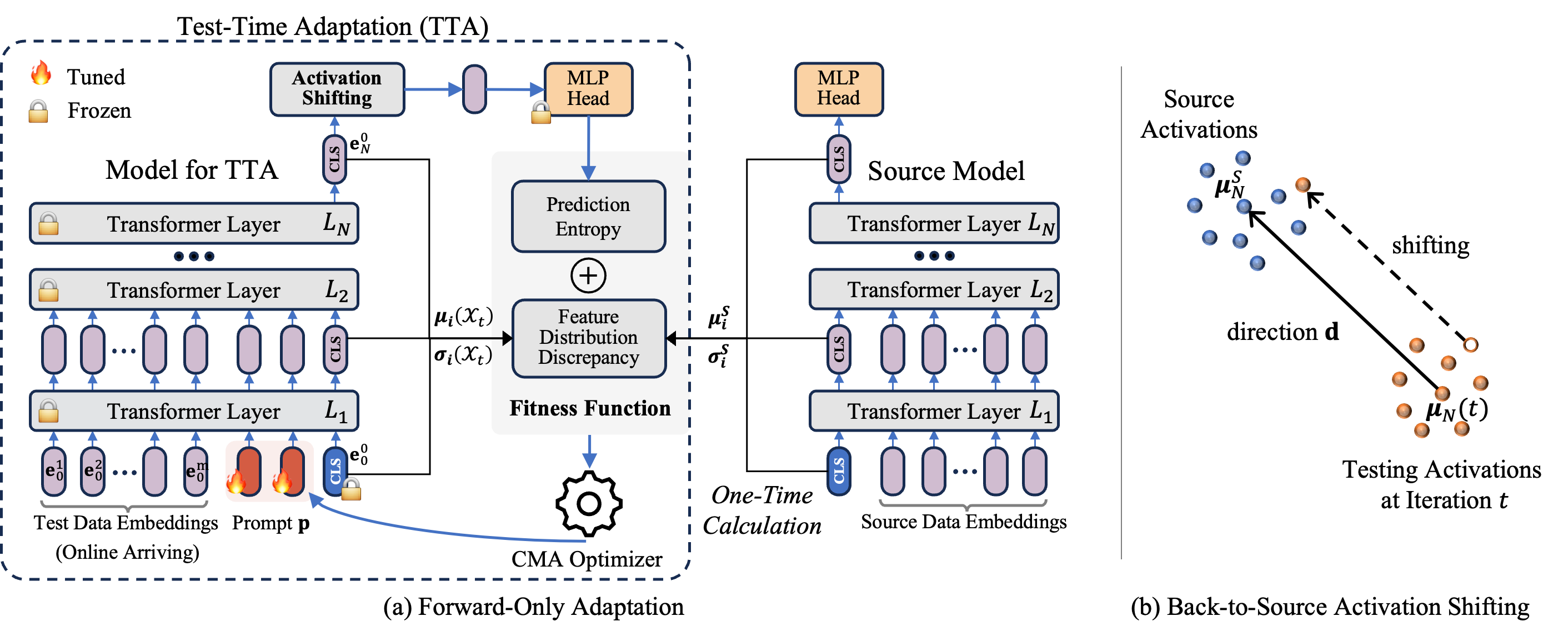This is the official project repository for Test-Time Model Adaptation with Only Forward Passes (ICML 2024, Oral) by Shuaicheng Niu, Chunyan Miao, Guohao Chen, Pengcheng Wu, Peilin Zhao
- 1️⃣ FOA conducts model learning at test time to adapt a pre-trained model to test data that has distributional shifts ☀️ 🌧 ❄️, such as corruptions, simulation-to-real discrepancies, and other differences between training and testing data.
- 2️⃣ FOA performs adaptation on both input and output levels, which avoids modification to model parameters and adapts in a backpropagation-free manner. Consequently, FOA offers the following benefits:
- reduces memory usage significantly, e.g., 5,165MB (Tent)
$\rightarrow$ 832MB when using ViTBase and a BS of 64. - compatible with quantized models, which typically do not support backpropagation.
- compatible with models on specialized chips, where parameters are hardcoded and non-modifiable.
- reduces memory usage significantly, e.g., 5,165MB (Tent)
Dependencies Installation:
pip install cma
pip install torch==2.1.0 torchvision==0.16.0 torchaudio==2.1.0 --index-url https://download.pytorch.org/whl/cu118
pip install timm==0.9.10
Data Preparation:
This repository contains code for evaluation on ImageNet-C/R/V2/Sketch with VitBase. But feel free to use your own data and models! Please check here 🔗 for a detailed guide on preparing these datasets.
Usage
from tta_library.foa import FOA
from models.vpt import PromptViT
model = TODO_model()
model = PromptViT(model, 3)
adapt_model = FOA(model, args.fitness_lambda)
train_loader = TODO_loader()
adapt_model.obtain_origin_stat(train_loader)
outputs = adapt_model(inputs)Usage (full precision experiments):
python3 main.py \
--data path/to/imagenet \
--data_v2 path/to/imagenet-v2 \
--data_sketch path/to/imagenet-sketch \
--data_corruption path/to/imagenet-c \
--data_rendition path/to/imagenet-r \
--algorithm [tent/foa/lame/t3a/sar/cotta] \
For experiments with quantized ViT, simply add
--quant
in the above command.
Experimental Results
The Table below demonstrates the result of both full precision and quantized ViTs. The reported average accuracy (%,
| ViT (full precision, 32-bit) | ViT (8-bit) | ViT (6-bit) | |
|---|---|---|---|
| NoAdapt | 55.5 / 10.5 | 54.1 / 10.8 | 47.7 / 9.9 |
| LAME | 54.1 / 11.0 | 52.5 / 12.4 | 45.8 / 10.4 |
| T3A | 56.9 / 26.8 | 55.1 / 25.9 | 45.4 / 30.1 |
| Tent | 59.6 / 18.5 | - | - |
| CoTTA | 61.7 / 6.5 | - | - |
| SAR | 62.7 / 7.0 | - | - |
| FOA | 66.3 / 3.2 | 63.5 / 3.8 | 55.8 / 5.5 |
Please see our PAPER 🔗 for more detailed results.
Please contact Shuaicheng Niu by [shuaicheng.niu at ntu.edu.sg] and Guohao Chen by [chenguohao987 at gmail.com] if you have any questions. 📬
If our FOA method or the setting of test-time adaptation with only forward passes is helpful in your research, please consider citing our paper:
@inproceedings{niu2024test,
title={Test-Time Model Adaptation with Only Forward Passes},
author={Shuaicheng Niu, Chunyan Miao, Guohao Chen, Pengcheng Wu, Peilin Zhao},
booktitle = {The International Conference on Machine Learning},
year = {2024}
}
